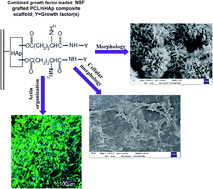Non-mulberry silk fibroin grafted poly(ε-caprolactone) nanofibrous scaffolds mineralized by electrodeposition: an optimal delivery system for growth factors to enhance bone regeneration†
Abstract
Mineralization of scaffolds enables them to mimic the chemistry of natural bone. Mineralizing nanofibrous scaffolds can successfully replicate both the architecture and chemical composition of bones and prove suitable for bone reconstruction. Non-mulberry silk fibroin (NSF) (from Antheraea mylitta) grafted poly(ε-caprolactone) (PCL) nanofibrous scaffolds (NSF-PCL) are fabricated using electrospinning, followed by aminolysis. Electrodeposition, due to its speed and simplicity is used to deposit calcium phosphate on these scaffolds at two deposition voltages: 3 V and 5 V. The deposition of nano-hydroxyapatite (nHAp) obtained is of high quality and its topology is dependent upon the voltage of electrodeposition. Along with scaffolds of nHAp deposited on a NSF-PCL matrix at 3 V and 5 V (NSF-PCL/3V and NSF-PCL/5V respectively), the unmodified NSF-PCL matrix is used as a control. The results of mechanical characterization and certain basic cell culture using the MG-63 cell line show the merits of NSF-PCL/5V over the other two compositions. The NSF-PCL/5V scaffold is then used for detailed cell culture studies after being loaded with growth factors like bone morphogenic protein-2 (rhBMP-2) and transforming growth factor beta (TGF-β) in a 1 : 1 (potency) proportion. Outcomes from these studies show a clear advantage of using a combination of the growth factors over using any one of them individually. Dual growth factor loaded matrices promote more significant expression of genes related to bone growth and better facilitate early differentiation of cells. The mineralized scaffolds thus created are mechanically suitable for bone tissue engineering and in combination with growth factors significantly enhance bioactivity, proliferation and differentiation of osteoblast-like cells. The engineered scaffolds hold the potential, with further development, to serve as an optimal alternative for bone tissue engineering.


 Please wait while we load your content...
Please wait while we load your content...